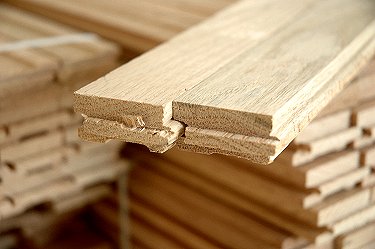Unfinished Hardwood Floors
Unfinished wood floors are one option amongst several choices you have when you're considering a wood floor. They fall under the category of "site-finished" floors because they're finished in the home, as opposed to to some off-site location like a manufacturing facility.
Given that you have other wood floor options, like pre-finished floors for example, the most common question is why go with unfinished wood flooring in the first place.
However like all the rest of the product choices available to us, each has its own advantages and disadvantages. Some situations might be better suited for a pre-finished wood floor but there are plenty of reasons and scenarios why an unfinished wood floor is the right option.
If you're on the fence about which way to go, or simply looking for some education about unfinished wood floors, read on.
What Exactly Is Unfinished Wood Flooring?
Its name says it all, but there's more to it than that.
Unfinished hardwood floors are made from bare wood stock that's sanded and finished in place in the home.
They differ from prefinished wood floors in that the wood used for prefinished floors is sanded, prepped and receives it's stain color and top coat at the manufacturing facility. There's no in-home sanding or finishing work.
With unfinished hardwood floors you buy the wood stock, anything from narrow strip to wide plank, and either install it yourself or have it installed by a professional. The wood is bare and is nailed down, sanded, stained (if desired) and sealed in place.
Why It Needs To Be Sanded & Finished In Place
When you buy an unfinished wood floor all of the wood will be milled to a specific thickness and width. However, there are still minute variations from board to board. Additionally, the subfloor that the wood floor is laid on is usually not perfectly flat either.The result of these typical but unavoidable imperfections is that when the boards are laid down next to each and nailed into the subfloor, there will be minute but perceptible ridges in the resulting floor. In other words, the edges of some boards won't always be perfectly flush with adjacent boards.
 Unfinished Red Oak Strip Stock
Unfinished Red Oak Strip Stock
These aren't gross mismatches mind you, and usually not visually perceptible. But if you rub your hand across a newly laid unfinished wood floor, you can feel these ridges and high points from board to board.
Consequently, an unfinished hardwood floor is sanded to achieve a nice smooth surface across the entire plane of the floor. With nice tight butt joints (where the sides of the boards meet each other) a sanded wood floor makes for a virtually uninterrupted surface.
Now with prefinished wood floors, the boards actually have a small bevel cut on the long edge of each piece. That bevel makes up for these variances, essentially eliminating those "high edges" that are typical with an unfinished wood floor.
However these small bevels on each side of a prefinished board form little "V" grooves in the floor. They can trap dirt and other foreign matter and can sometimes make sweeping (an essential element of good wood floor care) somewhat frustrating because the dirt keeps falling into those grooves.
The Benefits And Drawbacks
When you're choosing wood flooring you obviously have a choice between prefinished wood or a floor that's finished on-site. Given that a prefinished wood floor can be nailed down and walked on the same day, you might be wondering why go through the muss and fuss of installing the unfinished variety. Despite the inconveniences, an unfinished wood floor does have its benefits.
- No Real Limit To Your Choices
Bare, unfinished hardwood flooring is available in a wide array of species and configurations (narrow strip, wide plank, etc.). Unfinished Flooring After Nailing
Unfinished Flooring After NailingYou can also get reclaimed wood, flooring stock that's made from timbers salvaged from older structures or sunken logs.
On top of that, your color choices are endless and you can even have a stain color computer-matched to whatever shade you want. With prefinished wood floors, you're limited to what's manufactured, in the styles and colors that come out of the factory.
- No Edge Bevels
An unfinished hardwood floor doesn't have small edge bevels that result in grooves between the boards, making cleanup a bit more of a hassle. There's also a nice aesthetic quality associated with the smooth uninterrupted look of a wood floor. - A More Natural Look
This one might be subjective but there are some prefinished wood floors that, for lack of a better descriptor, have a "plastic" look to them. Often times it's the factory finish that's applied that makes it look this way. That's not to say that all prefinished floors look unnatural; it's just that there are some that have that tendency, unlike a site-finished wood floor ( again, it's subjective but something to watch for). - Ability To Match Existing Wood Flooring
If you already have wood flooring in one room and want to add new wood to an adjacent space, it's easier to do with unfinished wood stock. The new wood can be spliced in and the entire area refinished. Trying to match an existing floor with the same size and color of prefinished wood flooring might make a seamless result difficult to achieve.
And What about the drawbacks?
- Site-Finishing Gets Messy
Sanding an unfinished hardwood floor after it's nailed in place produces a lot of dust. Then there's the staining (if you so choose) and sealing that can stink up your home. Sealing off the area from the rest of the house helps but depending on the size and the location of the flooring, you're bound to get residual dust in places you don't want it. - Expertise Factors Into The Quality
Getting a quality job often times relies on the expertise of the installer. Mistakes with the sander or lack of knowledge on how to apply stain or sealer can result in a less-than-desirable outcome. An installer with experience who knows the ropes is often a good investment. Getting and checking references of qualified installers may offer you the best insurance.
 After Sanding...And Pretty Dusty
After Sanding...And Pretty Dusty
- Time Out Of Your House
You'll have to be out of your house for a time, perhaps several days, during the installation of unfinished hardwood flooring. Even if the area can be isolated and not walked on, you'll want to be out to avoid the fumes of the stain and/or seal coat. You also don't want to be around to raise dust when the finish is applied and drying. Having to go somewhere else for a few days interrupts your routine and can be inconvenient.
So what makes unfinished hardwood floors the right or wrong choice for you? Only you can decide that. But just remember to to keep in mind that in simplistic terms, an unfinished wood floor provides long-term benefits for the price of some short-term inconveniences (the site finishing stuff).
On the other hand, you could argue that a prefinished wood floor offers quick results but arguably, fewer design and style options.
Where To Get It & Sourcing Free Estimates
You've got several options when it comes to buying unfinished hardwood floors so you're not limited to just one resource.
- Local Flooring Retailers - these are your local floor stores that normally carry several types of flooring like carpeting, laminate floors, etc.
- Local Wood Floor Installers - most wood floor contractors and businesses that specialize in wood floor installation can/will source the wood for you.
- Lumberyards/Lumber Suppliers - if you're looking to purchase the wood yourself you can check out your local lumberyard for the types of wood they offer.
- Online Wood Floor Retailers - you can also source the wood yourself through retailers that sell their products over the internet. At a minimum, they provide a resource for price comparison shopping. They might also be a good source for some of the more exotic woods too, should you be unable to find them through a local source.
If you'd like help finding a local wood flooring contractor, take a moment to fill out the form below. It can provide you with several sources in your area that can potentially take on your flooring project. These contractors will contact you at your convenience and provide a free, no-obligation quote as well.
Here's More Related Info That Might Be Helpful...
Choosing Wood Flooring - Choosing the right wood flooring might seem like an overwhelming task. This article makes it easy to learn what you should know about wood floors and how to go about making the right choice.
Wide Plank Wood Flooring - Wide Plank wood flooring evokes a time when floors were made from old-growth forests. Find out what's available in this unique wood flooring choice.
Reclaimed & Recycled Wood Flooring - What better way to preserve out natural resources than with reclaimed wood. The best part is that reclaimed and recycled wood usually has an interesting story behind it. Find out more about floors with a history.
Exotic Hardwood Floors - Why not consider an exotic wood from the tropics as your next wood floor? Discover what's available as a way to bring a unique style to your home.
Birch Wood Flooring - Birch has the interesting characteristic of being hard like other hardwoods but yet with an interesting visual appearance. Find out more about and where to get it in this article.

Publisher's Comments
Unfortunately, I have some personal experience here. I had a new oak unfinished hardwood floor installed in my home that ended up with several mistakes, including some deep sanding divots and some mis-installed boards. It was clear to me after speaking with several different wood floor installers that there was a clear delineation in quality and level of expertise in the craft. I ultimately had to have several repairs done to get the results that should have been achieved the first time around.